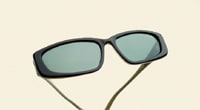HANDS ON - Eye on Equipment
The Sunglass Edge
by Susan P. Tarrant
We have long touted the benefits of edging lenses in-house: Savings in lower wholesale lab bills, same-day turnaround service, and quality assurance oversight, to mention a few.
But don't forget that edgers can supply you with another revenue track and patient service.
|
|
|
|
In-house sunwear work creates another revenue stream. Above: Nicole Miller style Roman Holiday for Signature Eyewear; below: Bace style from Sama Eyewear |
|

|
OVERLOOKED PROFIT
"ECPs overlook the opportunity to ask the patient whether he or she wants to buy a pair of prescription sunglasses, or a clip, which the ECP can fabricate in-house," observes Matt Vulich, vice president, sales for AIT Industries.
But, it's an opportunity that an increasing number of ECPs are grabbing, according to Shelton Green, regional sales manager for Briot-Weco USA.
ECPs can see a 35 percent to 40 percent savings on polarized sunwear, with up to 60 percent savings by tinting standard lenses. "The turnaround that you can offer by doing it in-house is also a big advantage," he adds.
"Right now, most ECPs with in-house edging equipment that can handle it are doing it," says Jay Cohen, director of professional sales for Gerber Coburn. Although there's not a great difference between edging tinted sunlenses and clear optical lenses, it gets trickier when there's a high plus or minus prescription, and when the lenses are to fit into a wrap frame with a high base curve.
KNOW YOUR EQUIPMENT
"Not all tracing systems can take a high-wrap frame. You have to know your tracer's limitations," Cohen says.
|
|
quick tips |
|
To get the most of your in-house tinting efforts: Change the dyes regularly; clean the lens thoroughly after edging; use a thermometer for independent verification; pick the correct lenses for your tinting equipment; when tinting the edge only, set the groove depth a minimal amount and apply tint with a tint pen; and practice, practice, practice. |
|
Older patternless edging systems (say, four years old) may not have capabilities to trace and edge lenses for wrap frames effectively. If your goal is to add that capability to your office's repertoire, you might want to think about upgrading.
"The ECPs with the newer equipment with 3D or 5D tracing are edging even high wraps effectively," Green says.
"Older patternless edgers can be a problem," he adds. "You've got to be able to set the bevel to backward or forward or even be able to move it around."
High base curve wrap frames don't allow the lenses to protrude through the back, so one needs to manipulate the placement of the bevel accordingly.
Also, newer edgers allow the operator to control the speed with which the lens is introduced to the edging wheel. "You want a lot of torque and twist," he says.
"If ECPs with the newest generation equipment are not edging sunlenses, it's not because the equipment can't handle it," Cohen says. "If the equipment is capable, there's no reason any ECP shouldn't be doing this."
|
helpful hints |
|
Even with equipment capable of adapting to the challenges of Rx lenses for high base curve frames, there's still some things to be mindful of when tackling the jobs, our experts say. HINT: Use extra caution when tracing curved frames, says Rick Noonkester, senior key account manager for Santinelli International. "You can mess up the tracer just by pressing 'trace,'" he explains. Be careful that the stylus does not get caught up on the bottom of the curve, which is where the nosepiece is located. HINT: If you can't get a binocular trace because of the nature of the frame, you can trace one side and then use a mirror image for the other, Noonkester says. Or, trace each side individually and enter a manual "distance between lens," adds Jay Cohen, director of professional sales for Gerber Coburn. HINT: Use the guided mode when edging to solve a multitude of issues, he adds. Use the 'front' position to eliminate the flattening of the bevel and a poor fit. "You're using the curvature of the lens instead of the curvature of the frame as your edging basis," Cohen says. HINT: Be wary of trying to fit high-plus or high-minus Rxs into a high wrap. "You need fairly thin lenses to fit into those curved frames," Noonkester says. HINT: Use white ink or a dark mark that will provide a pronounced dot when marking the optical centers, advises Cohen. |




